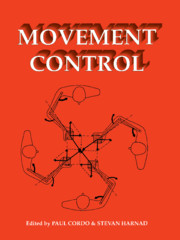Book contents
- Frontmatter
- Contents
- Preface
- 1 Does the nervous system use equilibrium-point control to guide single and multiple joint movements?
- 2 Does the nervous system depend on kinesthetic information to control natural limb movements?
- 3 Can sense be made of spinal interneuron circuits?
- 4 Implications of neural networks for how we think about brain function
- 5 Do cortical and basal ganglionic motor areas use “motor programs” to control movement?
- 6 Functional heterogeneity with structural homogeneity: How does the cerebellum operate?
- 7 Are movement parameters recognizably coded in the activity of single neurons?
- 8 The representation of egocentric space in the posterior parietal cortex
- Open Peer Commentary and Authors' Responses
- References
- Index
1 - Does the nervous system use equilibrium-point control to guide single and multiple joint movements?
Published online by Cambridge University Press: 11 December 2009
- Frontmatter
- Contents
- Preface
- 1 Does the nervous system use equilibrium-point control to guide single and multiple joint movements?
- 2 Does the nervous system depend on kinesthetic information to control natural limb movements?
- 3 Can sense be made of spinal interneuron circuits?
- 4 Implications of neural networks for how we think about brain function
- 5 Do cortical and basal ganglionic motor areas use “motor programs” to control movement?
- 6 Functional heterogeneity with structural homogeneity: How does the cerebellum operate?
- 7 Are movement parameters recognizably coded in the activity of single neurons?
- 8 The representation of egocentric space in the posterior parietal cortex
- Open Peer Commentary and Authors' Responses
- References
- Index
Summary
Abstract: The hypothesis that the central nervous system (CNS) generates movement as a shift of the limb's equilibrium posture has been corroborated experimentally in studies involving single- and multijoint motions. Posture may be controlled through the choice of muscle length-tension curve that set agonist-antagonist torque-angle curves determining an equilibrium position for the limb and the stiffness about the joints. Arm trajectories seem to be generated through a control signal defining a series of equilibrium postures. The equilibrium-point hypothesis drastically simplifies the requisite computations for multijoint movements and mechanical interactions with complex dynamic objects in the environment. Because the neuromuscular system is springlike, the instantaneous difference between the arm's actual position and the equilibrium position specified by the neural activity can generate the requisite torques, avoiding the complex “inverse dynamic” problem of computing the torques at the joints. The hypothesis provides a simple, unified description of posture and movement as well as contact control task performance, in which the limb must exert force stably and do work on objects in the environment. The latter is a surprisingly difficult problem, as robotic experience has shown. The prior evidence for the hypothesis came mainly from psychophysical and behavioral experiments. Our recent work has shown that microstimulation of the frog spinal cord's premotoneural network produces leg movements to various positions in the frog's motor space. The hypothesis can now be investigated in the neurophysiological machinery of the spinal cord.
- Type
- Chapter
- Information
- Movement Control , pp. 1 - 11Publisher: Cambridge University PressPrint publication year: 1994
- 24
- Cited by



